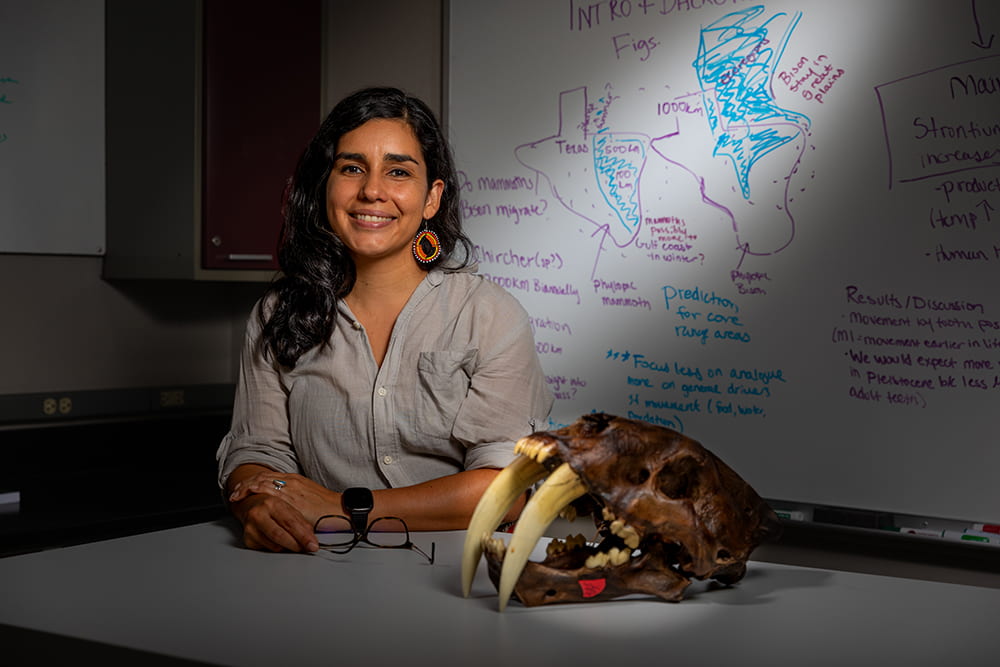Villaseñor Co-Authors PNAS Paper on Extinction of Megafauna

Anthropologist Amelia Villaseñor coauthored a paper describing the ecological effects of an extinction event that occurred more than 10,000 years ago in North America, one that had major consequences for the surviving mammal species.
The paper, titled “Late Pleistocene megafauna extinction leads to missing pieces of ecological space in a North American mammal community,” was published in Proceedings of the National Academy of Sciences, or PNAS, a journal of the National Academy of Sciences.
“Our findings show that the extinction of large-bodied animals, like mammoths, substantially changed how the remaining mammal communities were organized,” Villaseñor said. “The findings also suggest that human impacts have likely played a major role in large-scale degradation of North American ecosystems for thousands of years.”
Villaseñor’s research uses the remains of fossil mammals to understand how humans and other animals interacted with each other over the last 3.5 million years, as well as the ecological impacts of extinction.
For this study, to gain a better understanding of modern biodiversity loss, she and colleagues relied on the fossil record of mammals from the Texas Memorial Museum that span roughly 50,000 years ago to recent times. These collections include extinct megafauna from Texas. Megafauna are large-bodied mammals such as mammoths and sabertooth cats.
The researchers characterized the roles of extinct and surviving mammals using stable isotopes and body size. Stable isotopes are present in all parts of an animal’s body, and certain kinds of isotopes can stay preserved for millions of years. They provided Villaseñor and her team with a record of animal diets and how those diets changed through time.
The researchers also estimated the body size of animals, which gave them another piece of information about how animals interacted with their environment and each other. Together, this information describes the job an animal has in its community or its “niche.”
The team found that after the extinction, the surviving animal community was reorganized in what they ate and where they fell in the food chain, particularly among carnivores. Jaguars moved into a specialized dietary niche previously occupied by extinct cats like the sabertooth and the American lion. Puma, which were previously rare in the community, became common.
Biodiversity loss also led to “vacant niches,” or missing pieces, within the community, meaning that the roles of species such as mammoths, mastodons, and sabertooth cats were never again filled by the native mammal community. This biodiversity and ecological loss led to an overall reduction in ecosystem resilience that will affect the ability of native North American mammal communities to respond to future environmental changes.
The study’s lead author was Felisa Smith, biology professor at the University of New Mexico. In addition to Villaseñor, co-authors were Seth Newsome at the University of New Mexico, Emma Elliot Smith at the Smithsonian Institution and Kate Lyons and Catalina Tomé at the University of Nebraska-Lincoln.
Findings from this study support those of previous work published by Villaseñor this year in Nature Communications. The earlier study showed that mammal communities of North America have been homogenizing, or becoming more similar to one another, at faster rates over the last 10,000 years.
The earlier study also suggested lasting impacts from the megafaunal extinction on remaining mammal communities. Both studies showed that human impacts have likely played a major role in the reorganization and loss of resiliency of North American ecosystems for thousands of years.
The studies also have implications for the future.
“Our research of ancient mammals highlights what might happen if Earth’s remaining large-bodied mammals go extinct — animals such as elephants, rhinos, zebra, and lions — and it demonstrates how insights from the past can really inform modern conservation efforts,” said Smith.

